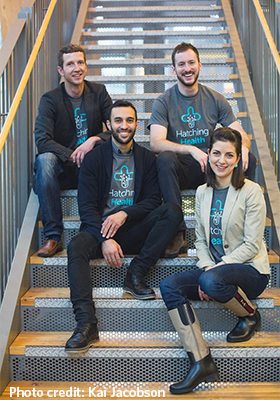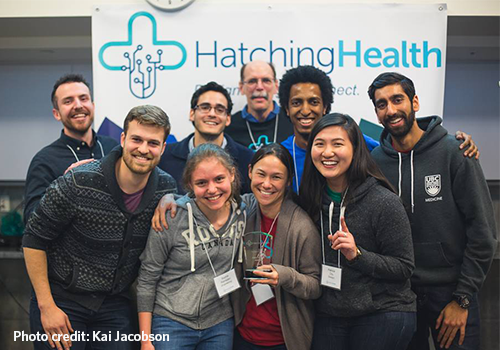
Hatching Health co-directors and UBC students Cameron Stuart (left), Ameen Amanian, and Daniel Raff alongside logistics coordinator, Ashley Anderson.
Photo credit: Kai Jacobson
As it turns out, not all great minds think alike.
And UBC’s recent, interdisciplinary event, Hatching Health, offers proof.
The weekend-long — and student-led — initiative saw upwards of 80 participants (including 30 students from UBC’s Faculty of Medicine) come together to ‘hatch’ a solution to some of today’s pressing healthcare problems.
“There’s a need for more collaboration between the people experiencing healthcare problems and the individuals with the technical skills to solve those problems,” says Master of Biomedical Engineering student Cameron Stuart, who co-directed the event alongside UBC medical students Daniel Raff and Ameen Amanian.
The competition, which took place at the Wayne and William White Engineering Design Centre in March, kicked off with an evening of introductions and networking, giving participants the opportunity to connect with fellow students and mentors from a broad range of backgrounds, including healthcare, biomedical engineering and design.
The following day, after a round of pitches, ten teams split off, each forming around a unique medical challenge. Given only 24 hours to come up with a viable solution, teams set to work, drawing on their diverse skillsets and backgrounds.
“I went into the competition expecting to get a full night of sleep,” recalls Master of Occupational Therapy student Darren Wiebe with a chuckle. “We worked into the night.”
But the long hours and hard work were well worth the effort.
Wiebe, together with his team members — occupational therapist Jen Gellis, product designer Patricia Chu, UBC alumnus Daniel Millar (Mechanical Engineering) as well as UBC students Armaan Malhotra (Medicine) Abenezer Teklemariam (Engineering Physics), Sophie Ramsden (Mechanical Engineering), and Juan Pablo Gomez (Biomedical Engineering) — landed first place at the competition.
“We were all in a bit of disbelief,” says Wiebe, recounting the moment his team, Smart Curve, was called up to the stage to receive The Geyer Family First Place Award, a monetary prize of $1500 in addition to a meeting with Paul Geyer, a Vancouver-based entrepreneur and Chair of Social Venture Partners.
“A lot of teams had apps developed, or a working prototype ready by the time it came to present,” says Wiebe.

Smart Curve team (left to right) Darren Wiebe, Daniel Millar, Juan Pablo Gomez (back), Sophie Ramsden (front), Geof Auchinleck (back; mentor), Jen Gellis (front), Abenezer Teklemariam, Patricia Chu, Armaan Malhotra.
Photo credit: Kai Jacobson
And while Smart Curve may not have had a ‘physical’ solution to showcase to the panel of judges, what the team was able to demonstrate was an intimate understanding of the medical challenge they had been presented with, and a carefully-considered, patient-centered solution.
“We must have spent 6 or 7 hours just breaking down the problem,” recalls Wiebe.
Their medical challenge — put forward by team member and pediatric occupational therapist Jen Gellis — was to streamline the process of creating custom-molded seating systems for children with complex positioning needs, such as a significant scoliosis.
“Children with complex orthopedic needs often require a custom-molded seating system for their wheelchair. These seats currently take three to four appointments, and many more hours to fabricate,” explains Gellis.
“For families living outside greater Vancouver, where the seating technicians and workshops are located, this means taking time off work and school to travel to the city to be fitted for these systems. The process puts a strain on the child, their family, and the overall healthcare system,” she adds.
After hours of discussion and debate, and exploring current solutions on the market, members of Smart Curve devised an innovative plan to reduce the process to a single appointment, rather than three or four.
“Essentially, what we proposed was digitally capturing the contours of the child’s body to create an image that could be sent to a 3D printing processor, where the contours could be cut from a foam block and ultimately used to fabricate the chair. Once ready, the chair would be shipped to the client’s home, where a local occupational home-health therapist would receive telemedicine support of a seating specialist to ensure a good, final fit for the child,” explains Wiebe.
Their presentation, and plan to leverage telemedicine to support children needing custom-molded seating systems, certainly caught the attention of the judges, who recognized the potential impact their proposed solution could have on clients and the healthcare system.
And while Smart Curve team members are excited by moving their venture forward — starting with a series of consultations with technicians, healthcare practitioners, and researchers — they’re also thrilled about the new perspective they’ve gained from participating in the competition.
“The whole process was very educational. By collaborating across disciplines, you see things that you wouldn’t otherwise see if you were only working with others in your field. Together we were able to come up with a viable solution to a healthcare problem that could actually make a real difference to some of my future clients,” says Wiebe, who hopes to specialize in wheelchair seating after he wraps up his Master of Occupational Therapy next year.
Event organizers, Stuart, Raff and Amanian, hope to see the momentum from this year’s competition continue, with the ultimate goal of seeing Hatching Health become an annual, interdisciplinary event.
“It’s all about bringing diverse skills and knowledge together to solve problems,” say Stuart, Raff and Amanian.
An interdisciplinary approach is one thing these great, young minds can all agree on.
For more information about Hatching Health, and a full list of team winners, visit http://www.hatchinghealth.ca/
For more details of how Hatching Health came to UBC, read this Q+A with co-founders and UBC medical students, Daniel Raff and Ameen Amanian.
Key sponsors of Hatching Health included: UBC Faculty of Medicine, UBC Faculty of Applied Science, Genome BC, the Vancouver Coastal Health Research Institute, the Michael Smith Foundation for Health Research, UBC Biomedical Engineering, UBC Department of Electrical and Computer Engineering, and Doctors of BC.